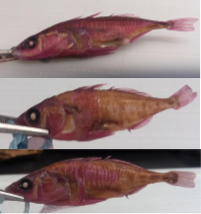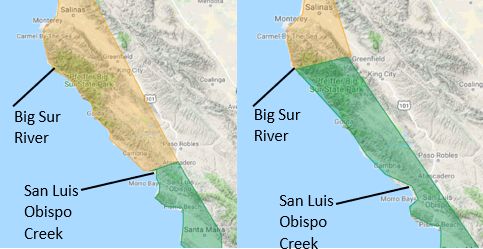People often assume evolution occurs very slowly. At its core, evolution is the change in the genetic composition of populations over time. In many cases, these changes result from adaptation: individuals with beneficial heritable traits will survive and reproduce at a higher rate, thus these traits and their underlying genes will increase in the population over time. Recent research has shown that evolutionary change can occur rapidly in nature.
 The Threespine Stickleback (Gasterosteus aculeatus) is a small fish, which breeds in fresh or brackish and then swims into the ocean. Threespine stickleback are often used as a model organism to study rapid evolution because they have been shown to rapidly evolve bony plates in the presence of predators or certain environmental conditions.
The Threespine Stickleback (Gasterosteus aculeatus) is a small fish, which breeds in fresh or brackish and then swims into the ocean. Threespine stickleback are often used as a model organism to study rapid evolution because they have been shown to rapidly evolve bony plates in the presence of predators or certain environmental conditions.
The bony plate phenotypes are strongly correlated to a gene called Ectodysplasin A or EDA. Because of the strong association between genotype and phenotype, alleles at the EDA gene are easy to track over time. EDA is expressed in three different phenotypes: completely plated (bony plates cover snout to peduncle), low plated (bony plates cover from snout to just behind the pectoral fins), and partially plated (bony plates cover more of the fish than low plated morphs and have less than completely plated morphs). Completely plated individuals are homozygous for the ancestral EDA gene and low plated individuals are homozygous for the derived EDA gene. Fish that are heterozygous often appear phenotypically partially plated, but some individuals can appear phenotypically low plated or completely plated.
A study done in the late 1970s and early 1980s, by researchers from the University of California Los Angeles, found stickleback plate phenotype had gradient in estuaries along the coast of California. In Northern California, populations were polymorphic for plate morph - in other words, all three plate morphs were present. However, south of San Luis Obispo, the researchers found monomorphic populations, which only contained the low plate morph.

Distribution of all three morphs (orange), and > 80% low plated
morphs (green) of threepsine sticklebacks, 40 years ago (left)
and today (right).
Working with Simone Des Roches, a postdoctoral fellow in the Palkovacs lab, I studied how the genotypes and phenotypes of three plated forms may have changed over the past 50 years. I wanted to see whether the transition from polymorphic populations to monomorphic populations had shifted. Collecting specimens in estuaries between Monterey County and San Luis Obispo County, I found that many populations still contained partially plated individuals. The previous study only looked at the plate phenotypes. They found the complete plated phenotype as far south as San Simeon Creek, the farthest south I found populations with completely plated phenotypes was Big Sur River. Thus, it was found that populations containing completely plated morphs has receded northward. South of Big Sur river, populations contained partially plated individuals but were composed of mostly low plated individuals.
To add to the study done by the UCLA researchers, which did not include information on genotype, we collected genotype data to compare to my phenotype data. First, we looked to see how the phenotypes and genotypes (homozygous for low plated, homozygous for highly plated, and heterozygous for partially plated) were distributed across the populations. Second, we were interested to see if heterozygous individuals appeared as either phenotypically complete or low plated. We found that the complete phenotype and genotype were found as far south as Big Sur River. Low plated phenotype and genotype was found south of Big Sur River with populations being 80% or higher as homozygous for the low EDA gene. Partially plated phenotypes were found at many sites but did not make up a large portion of the sample collection. I used the genotype to confirm that the phenotype (complete or low) correlated with the inferred EDA genotype that previous studies had found.
Surprisingly, we found the partially plated genotype, usually heterozygous at the EDA locus, were found in individuals who were both phenotypically low or complete as well as phenotypically partially plated. In some sites, the heterozygous genotype was more frequent than the partially plated phenotype. Thus, alleles that might be selected against, either for a low plated or high plated morph, might be able to “hide” from selection by being preserved in a heterozygous individual with a high or low plated phenotype. The widening of the range of low plated forms could be due to heterozygote low plated individuals remaining in the population.
One hypothesis that might explain these changes in phenotypes is changes in the habitat due to climate change. Because stickleback inhabit estuaries, differences in wave action which affect the amount of sand that is deposited near the mouth of an estuary. The changes in sand deposition can alter the amount of time an estuary is in direct contact with the ocean. Wave action from the ocean can close the estuary to form what’s called a bar-built estuary. Closure of an estuary can isolate populations from possible input from the ocean. In bar-built estuaries, plate counts due to different selective pressures. As the climate changes, decreases in precipitation could change how three-spined stickleback move in and out of estuaries. This restricted movement could be driving changes in the expression of the EDA gene. My study shows how climate change might be driving the evolution of a trait. This can be used to demonstrate how humans may be altering natural evolution processes by driving climate change.
This work was recently published in Global Change Biology.
We thank the Norris Center for funding this project.
